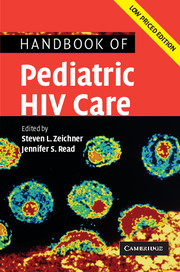Book contents
- Frontmatter
- Contents
- List of contributors
- List of abbreviations
- Foreword
- Preface
- Part I Scientific basis of pediatric HIV care
- Part II General issues in the care of pediatric HIV patients
- Part III Antiretroviral therapy
- Part IV Clinical manifestations of HIV infection in children
- Part V Infectious problems in pediatric HIV disease
- 30 Serious infections caused by typical bacteria
- 31 Tuberculosis
- 32 Disseminated Mycobacterium avium complex infection
- 33 Fungal infections
- 34 Herpesvirus infections
- 35 Pneumocystis jiroveci pneumonia
- Part VI Medical, social, and legal issues
- Appendix 1 Formulary of antiretroviral agents
- Appendix 2 National Institutes of Health sponsored clinical trials for pediatric HIV disease
- Appendix 3 Selected HIV-related internet resources
- Appendix 4 Selected legal resources for HIV-infected children
- Index
- References
32 - Disseminated Mycobacterium avium complex infection
Published online by Cambridge University Press: 23 December 2009
- Frontmatter
- Contents
- List of contributors
- List of abbreviations
- Foreword
- Preface
- Part I Scientific basis of pediatric HIV care
- Part II General issues in the care of pediatric HIV patients
- Part III Antiretroviral therapy
- Part IV Clinical manifestations of HIV infection in children
- Part V Infectious problems in pediatric HIV disease
- 30 Serious infections caused by typical bacteria
- 31 Tuberculosis
- 32 Disseminated Mycobacterium avium complex infection
- 33 Fungal infections
- 34 Herpesvirus infections
- 35 Pneumocystis jiroveci pneumonia
- Part VI Medical, social, and legal issues
- Appendix 1 Formulary of antiretroviral agents
- Appendix 2 National Institutes of Health sponsored clinical trials for pediatric HIV disease
- Appendix 3 Selected HIV-related internet resources
- Appendix 4 Selected legal resources for HIV-infected children
- Index
- References
Summary
Non-tuberculous mycobacteria are major opportunistic pathogens of HIV-infected children and adults who have severe immunosuppression. Organisms of the Mycobacterium avium complex are the predominant pathogens, typically causing systemic infection, (referred to as disseminated M. avium complex infection or DMAC). With the advent of highly active antiretroviral therapy (HAART) and the resulting improved preservation of immune competence, DMAC infection has become less common [1]. Among HIV-infected children with advanced disease, however, DMAC infection remains an important cause of morbidity and mortality, so that prevention and management of non-tuberculous mycobacterial infection are important aspects of the care of children with AIDS.
Epidemiology
Mycobacterium avium and many of the other non-tuberculous mycobacteria are widely distributed in the environment. They are found in water and soil in nature and have been identified in food and in institutional water systems [2, 3]. These organisms are uncommon causes of infection in normal hosts, and thus are opportunistic pathogens in patients with depressed cell-mediated immunity, including those with HIV infection.
While DMAC infection is a major opportunistic infection in North America and Western Europe, it is uncommonly identified in persons with AIDS in Africa or other less-developed areas of the world. It is not known whether this difference reflects differences in distribution of pathogenic strains of MAC in the environment. Almost certainly, part of this difference is the result of lack of blood culture testing to identify DMAC infection in these settings.
- Type
- Chapter
- Information
- Handbook of Pediatric HIV Care , pp. 685 - 694Publisher: Cambridge University PressPrint publication year: 2006



